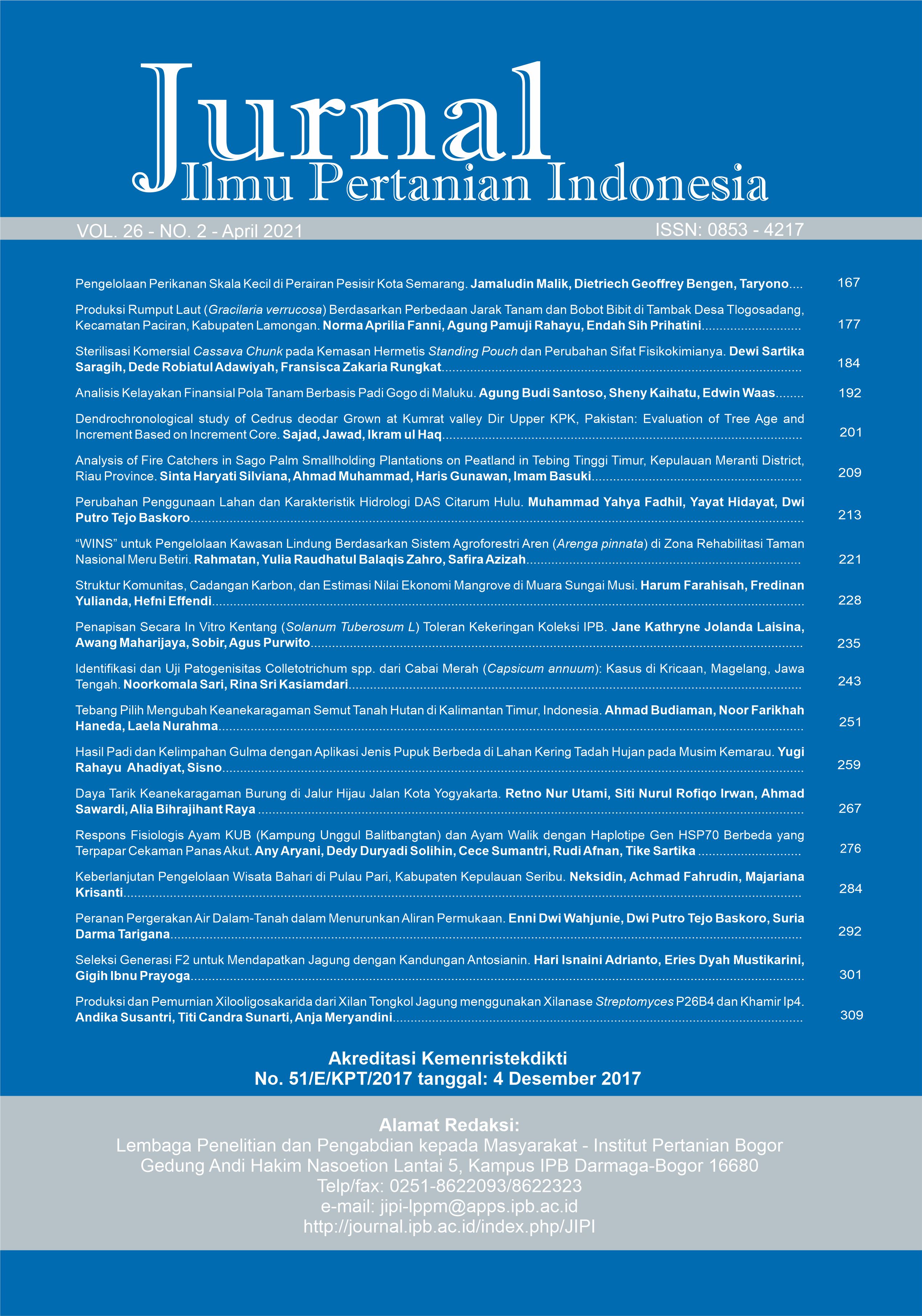Analysis of Fire Catchers in Sago Palm Smallholding Plantations on Peatland in Tebing Tinggi Timur, Kepulauan Meranti District, Riau Province
Abstract
Fire on peatlands takes place not only in areas where preparation for cultivation is in progress, but also in areas that have been cultivated, such as for sago palm growing. One of the important factors that influence the vulnerability of cultivated peatlands to fire is the availability and amount of biomass fuel that easily catches fire, such as ferns, grasses, and broadleaved shrubs in their living as well as dead (litter) stages. The present study concerns the vulnerability of peatland utilized for sago growing by smallholders, focused in Tebing Tinggi Timur, Kepulauan Meranti District, Riau Province. The objectives of this study were to analyze the composition and assess the biomass of fire catchers in the sago palm plantation. Data collection was conducted in three locations in Kepau Baru Village. In each location, a 1000 m-long transect line was drawn and 10 sampling plots of 2 m x 2 m were established along the line with 100 m intervals. Results showed that total biomass of fire catchers in this growing system was averaged at 24681 kg/ha, in which the dead plant fraction was predominating (average at 17478 kg/ha or 70.81%) over the living plant fraction (in average 7203 kg/ha or 29.19%). The latter consisted of ferns that averaged at 2.191 kg/ha or 30.42%, grasses (20 kg/ha or 0.28%), non-woody broadleaved shrubs (581 kg/ha or 8.07%), and woody broadleaved shrubs (4411 kg/ha or 61.24%). The amount of fire catchers in relatively large quantities in this plantation system could magnify fire risk during drier months, especially during El-nino years.
Keywords: biomass, fire risk, grasses, non-woody broadleaved shrubs, woody broadleaved shrubs
Downloads
References
Baeza M J, Lui M D, Raventos J, Escarre A. 2002. Factors Inf luencing Fire Behaviour in Shrublands of Different Stand Ages and the Implications for Using Prescribed Burning to Reduce Wildfire Risk. Journal Environment Management. 65(2): 199208. https://doi.org/10.1006/jema.2002.0545
Bintoro MH, Purwanto, Amarilis S. 2010. Sagu di Lahan Gambut. Bogor (ID): Institut Pertanian Bogor Press.
Brown S. 1997. Estimating Biomass and Biomass Change of Tropical Forest-A Primer. FAO Forestry Paper 134. Urbana (EN): FAO.
Brown, Davis. 1973. Forest Fire Control and Use. New York (US): McGraw-Hill.
Chandler CP, Cheney P, Thomas L, Trabaud, Williams D. 1983. Fire in Forestry: Forest Fire Behavior and Effects. Vol 1. NewYork (US): Jhon Willey and Sons, Inc.
Clar CR, LR Chatten. 1954. Principles of Forest Fire Management. New York (US): Mc. Graw Hill Book Company.
Harrison ME, Page SE, Limin SH. 2009. The Global Impact of Indonesia Forest f ire. Journal of Biological Education 56(3): 156163.
Haryanto B, Pangloli P. 1992. Potensi dan Pemamfaatan Sagu. Yogyakarta (ID): Penerbit Konisius.
Hooijer A, Silvius M, Wösten H, Page S. 2006. PEAT-CO2. Assessment of CO2 emissions from drained peatlands in SE Asia.
Mason CF. 1977. Decomposition. The Institute of Biology. Studies in Biology No. 74. London (ID): Edward Arnold.
Murdiyarso D, Rosalina U, Hairiah K. Muslihat L. Suryadiputra INN, Jaya A. 2004. Petunjuk Lapangan: Pendugaan Cadangan Karbon pada Lahan Gambut. Proyek Climate Change. Forest and Peatlands in Indonesia. Wetlands International – Indonesia Program dan Wildlife Habitat Canada. Bogor Indonesia. Bogor (ID).
Pittameka AL, Muhammad A, Gunawan H, Irawan A F 2016 Analisis Struktur Tegakan Sagu (Metroxylon Sagu Rottb.) dalam Dua Sistem Pertanaman pada Lahan Gambut [skripsi]. Pekanbaru (ID): Universitas Riau.
Rieley JO, Wüst RAJ, Jauhiainen J, Page SE, Wösten H, Hoijer A, Siegert F, Limin S, Vasander H, Stahlhut 2008. Tropical peatlands: carbon store. carbon gas emissions and contribution to climate change processes. International Peat Society. p 148181
Saura Mas S, S Paula, JG Pauses, Lloret F. 2010. Fuel Loading and Flammability in the Mediterranean Basin Woody Species with Different Post-Fire Regenerative Strategies. International Journal of Wildland Fire 19: 783794. https://doi.org/10.1071/WF09066
Wagner VCE. 1987. Develompment and Structure of the Canadian. Forest Fire Weather Index. Journal of Forest Research. 35(7): 2334.
Wilson RJ. 1985. Observations of Extinction and Marginal Burning States in Free-Burning Porous Fuelbeds. Combustion Science and Technology 44 (4): 179–193. https://doi.org/10.1080/ 00102208508960302
This journal is published under the terms of the Creative Commons Attribution-NonCommercial 4.0 International License. Authors who publish with this journal agree to the following terms: Authors retain copyright and grant the journal right of first publication with the work simultaneously licensed under a Creative Commons Attribution-NonCommercial 4.0 International License. Attribution — You must give appropriate credit, provide a link to the license, and indicate if changes were made. You may do so in any reasonable manner, but not in any way that suggests the licensor endorses you or your use. NonCommercial — You may not use the material for commercial purposes.






















